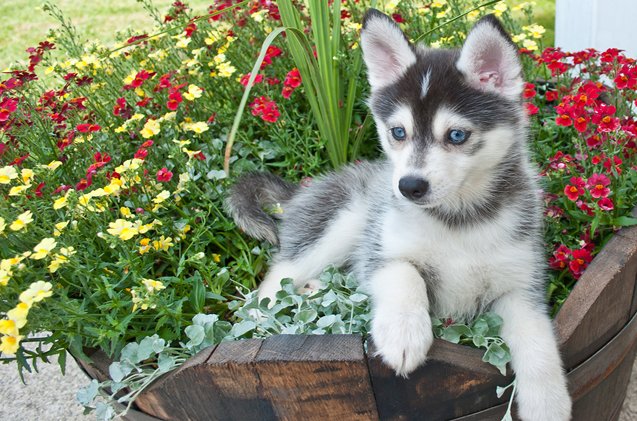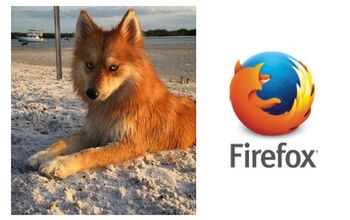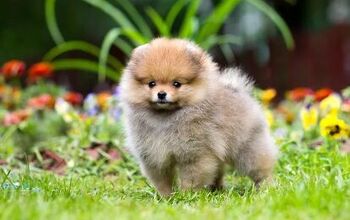Pomsky

One of the more recent additions to the designer dog arena, Pomskies are a result of a crossing between a Siberian Husky and a Pomeranian.

About Pomsky
We are committed to finding, researching, and recommending the best products. We earn commissions from purchases you make using the retail links in our product reviews. Learn more about how this works.
Pomsky Basics
Pomsky puppies look like fluffy miniature wolves and it’s this unique appearance that has dog lovers all over the world completely infatuated. Apparently, everyone in the world wants to hug a wolf. Sadly, that’s not a particularly good idea overall. So, Pomskies are a noble substitute for this inexplicable need. These adorable pooches are one of the more recent additions to the designer dog arena. Pomskies are a result of a crossing between a Siberian Husky and a Pomeranian. Strange bedfellows, to be sure. But their babies? Absolutely gorgeous!
As it is the case with most hybrid breeds, the physical appearance of a Pomsky puppy can be somewhat unpredictable. It will be cute, but beyond that it’s hard to say what will pop out of the mamma pup. Additionally, since it’s a fairly new mix, Pomsky breeders are still tweaking the ‘perfect’ look to become the breed’s standard. However, most enthusiasts seem to gravitate towards a “Huskeranian” look. This is a dog that looks quite similar to a Husky, but is much smaller in size. Of course with this sort of breeding you never know exactly how it’s going to turn out. There may be more Husky in one pup, while another pup in the exact same litter will have more Pomeranian in them. You never know! Most f1 Pomsky puppies, or first generation litters, are 50/50 Pomsky. That means that their father was a Pomeranian and their mother was a Siberian Husky. The 25/75 Pomsky puppies are a mix of a Pomsky and a Pomeranian. This dilutes the Husky genes,which makes for a smaller dog that’s more suitable for apartment living amongst other things.
The Pomsky’s temperament can also be varied depending on each parent’s genetic contribution, but they are generally considered to be highly intelligent, loving, and playful dogs. It’s really just a question of how intelligent, loving, and playful these pups turn out to be.
Origin
Pomskies are a relatively new breed of ‘designer dog’ that is gaining rapid popularity across North America and parts of Europe. Funnily enough, the Pomsky breed began as an Internet myth in 2011, when people were posting cute pictures of fluffy puppies and claiming they were Pomeranian and Husky mixes (they were not, but they were coming!). However, the crucial moment in the breed’s history was a Buzzfeed article published in 2011. This piece that quickly went viral featured pictures of a Finnish Lapphund puppy and got the public in an absolutely frenzy over the adorable doggos. It didn’t matter that the breed didn’t actually exist. People loved the combination and it was only a matter of time before someone made this doggo dream a reality.
Related: 10 Best Harnesses For Your Pomsky
Once breeders recognized that there’s a huge interest in Pomsky puppies, they got to work and started creating what is now one of the most popular designer dog breeds around. Unfortunately, natural breeding is not an option for a variety of reasons. So, that requires breeders to go to great lengths to obtain Pomsky litters. Don’t worry, nothing illicit happens to bring Pomsky puppies into the world. They just aren’t made the old fashioned way. Our good friend science comes into play.
Both because of the difficulty of breeding and the fact that Pomsky puppies are still quite rare, these cute puppies are very expensive. According to the Pomsky Club of America, reputable breeders don’t charge anything less than $2,000 for their puppies, and even that’s for puppies that don’t have all of the most desirable traits. For a Pomsky with blue eyes and distinct Husky appearance, you can expect to dish out at least $3,000. Similarly, popular color combinations such as Merle Pomsky puppies will cost more than, let’s say, “plain” black or brown Pomsky. Bringing these pups into your life won’t be cheap, but the results are undeniable.
Pedigree
The super cute Pomsky (or Huskeranian as some prefer to call them) is a mix of two pure breeds: Pomeranian and Siberian Husky. But, as most people can realize once they see the two breeds compared, it is not possible to get a mix of them the natural way. To get a Pomsky litter, breeders have to artificially inseminate a Siberian Husky female with a Pomeranian male sperm and hope it works the first time around. The reason for the complicated breeding process is the difference in the size of the two breeds: Pomeranian females can’t bring puppies sired by a larger Husky male to term without risking their health. Puppies would be too big for them to give birth to (not to mention the impossibility of mating) and could even endanger the mother’s life. Even if you consider a match between a Pomeranian male and a Husky female, the difficulties are clear once again – it simply wouldn't work on its own. In this case, it is best for breeders to do this one themselves rather than trying to let nature take its course.
Related: 10 Best Toys For Your Pomsky
Since the Pomsky breed is considered a crossbreed or a designer dog if you prefer, they are not recognized by the American Kennel Club which only considers purebred dogs for recognition. However, that doesn’t mean that there is no chance of getting pedigree papers for your Pomsky puppy – you can still get proof of healthy, quality lineage for your crossbreed dog even if it’s not from AKC. Reputable Pomsky breeders can register their litters for a certified pedigree with the International Pomsky Association, a reputable breed club dedicated to this popular designer dog. To obtain a pedigree for their puppies, breeders have to submit information about their lineage and ensure that their litter is up to the breed’s standard and completely healthy. This is why it’s important to look for Pomskies with a pedigree, as it’s a sign you’re getting your pup for a responsible breeder and not a puppy mill. Backyard breeders won’t screen their puppies for health issues, won’t pay attention to their lineage, and will keep their dogs in horrific, inhumane conditions – not only is it cruel to support these operations by buying from them, but it will also guarantee you a dog that is prone to health issues and even behavioral problems. In other words, don’t forget to check your pup’s papers before bringing him or her home!
Food / Diet
Pomskies usually possess a great deal of energy and are extremely playful, so they need the right fuel to keep them going! Yet even though these are the traits they’ve gotten from their Husky ancestors, it doesn’t mean they should eat the same foods as their ancestors. You should always keep in mind that Pomskies come in a smaller package than Huskies and as a result will have different nutritional needs than both of their ancestral breeds.
They should be provided with a high-quality variety of dry kibble that can supplement all their dietary needs, and one of the deciding factors will be your dog’s size. Pomsky’s come in 3 different sizes: toy Pomsky (5 to 9 lbs), mini Pomsky (9 to 18 lbs), and standard Pomsky (18-25 lbs). In other words, they might do just fine on a formula for medium breed dogs or will need a formula that caters to the needs of mini breeds – it will depend. In addition to size, be sure to consider their age and activity level, as seniors and puppies don’t have the same needs, as well as dogs who are active and those who live as couch potatoes. Last but not least, you should be very mindful of the ingredients in the food you give to your Pomsky. The first ingredient should always be real meat, followed by healthy fats, some complex carbs, and of course a range of vitamins of minerals. It should be free of artificial ingredients and cheap fillers that can only harm your pet’s health in the long run.
If you’re unsure which brand of kibble or diet is the best choice for your dog, consult with your vet. It’s always best to keep your vet involved with your dog’s diet to ensure that your pup lives the longest and healthiest life possible.
This is a sponsored placement
One taxing issue that affects many dogs, including Pomskies, is allergies. Certain sensitivities to food can cause a myriad of issues for your little designer dog, from itchiness and dry skin to more serious symptoms such as gastrointestinal upset and severe skin reactions resulting in hotspots and hair loss. Naturally, the first step of the road to recovery from food sensitivities is transforming your pet’s diet by opting for veterinarian-formulated foods such as Hill’s® Prescription Diet® z/d Skin/Food Sensitivities Dog Food. This formula is created especially for sensitive dogs that react to specific foods or have sensitive skin that is easily irritated: to prevent an adverse reaction this formula uses highly hydrolyzed animal protein and purified carbohydrate sources. To boot, this complete and balanced food contains no gluten, soy protein, lactose, or any artificial colors, flavors, or preservatives. The formula is also enriched with vitamin E, natural fibers, essential fatty acids, and antioxidants, all in service of better digestion and healthier skin and coat. If your little Pomsky has been scratching like a maniac or has an upset tummy after every meal, it might be time to switch their food for something vetted by experts – and formulated specially to treat such issues.
Related: 10 Best Collars For Your Pomsky
Training
Pomskies are highly intelligent and respond well to reward based training methods. However, they can sometimes inherit the Pomeranian’s stubbornness and the willfulness of the Siberian Husky. That’s a tough combination for training and should therefore be handled with calm and assertive leadership. Failure to do so can result in “small dog syndrome” and other behavioral problems. For instance, Pomskies can be prone to resource guarding like the Pomeranians, and catching early signs of this behavioral issue will help you eliminate it before it becomes a serious issue. In any case, the key is to use positive reinforcement methods and steer clear from punishments and other cruel and outdated methods of dog training. Not only that it can be abusive, but it will also be completely counterproductive with your Pomsky – they’ll only dig in their heels and get even more stubborn if you try to force them into doing something.
For most new dog owners, it’s important to start with the basics such as potty training and learning to walk on a leash. Depending on the breeder you’ve got your Pomsky from and the puppy’s age, they might already know a trick or two, but it’s also highly likely you’ll need to be the one who housetrains them. Training a puppy is not an easy task, but it’s important to teach your Pomsky fur baby manners while they’re still young. If they sniff out that you’re not an alpha, they’ll shamelessly exploit your weak side to their advantage. Any smart pupper is capable of this, so it’s always important to establish your alpha role in the relationship early and often. Fail to do so, and you’ll have a puppy that repeatedly pees and poops wherever they happen to be when the need strikes, that chews your shoes and furniture, and generally disobeys everything you say – and that’s no fun for anyone.
Related: 10 Best Bowls For Your Pomsky
Weight
The average weight of any hybrid breed doggo is usually estimated as the average weight of its two parents. Pomskies can therefore weigh anywhere between 20 to 30 pounds, but there are some exceptions. Toy Pomskies weigh up to 9 pounds, and mini Pomskies weigh 9 to 18 pounds. That’s quite a wide range for any breed of dog, so you’ll want to make sure that you know exactly which type of Pomsky that you buy from your breeder to avoid any unpleasant surprises down the road.
Temperament / Behavior
Like their physical characteristics, the Pomsky’s temperament can sometimes be tough to predict, and will depend entirely on each puppy’s individual genetic makeup.
More often than not, Pomskies inherit the desirable traits from both Siberian Huskies and Pomeranians. That is to say that they are often highly intelligent, loving, playful, and self-assured. These are of course, traits that both the Siberian Husky and the Pomeranian possess.
Of course, there are some personality traits that could be considered less than ideal that these cute Huskeranians can inherit as well. For instance, Huskies are known as talkative dogs with their vast repertoire of howls and whines, while Pomeranians are big barkers. Sometimes, this means that their offspring can be particularly yappy too. If you are particularly sensitive to noise, it’s important to keep this in mind before committing to a Pomsky.
Related: 10 Best Leashes For Your Pomsky
Like Pomeranians, Pomskies are highly protective of their owners and can grow into great guard dogs. They will often attempt to take on any adversary that they view as a threat to their family despite their small size. This can be both adorable and annoying, depending on the pup.
Unlike Huskies, Pomeranians can sometimes be skittish around young children and some Pomsky puppies can display this tendency. So, keep that in mind if you plan on bringing a Pomsky into a large family.
In any case, it’s important to note that there is no written rule about how Pomsky dogs will behave, because this is still an evolving breed and there isn’t enough information available about any breed-specific character traits. What we do know, however, is that with proper training and socialization, any puppy will grow up in a well-balanced, well-mannered and loving dog, and it’s no different for Pomeranian and Husky mixes. So, even if Pomsky have some genetic traits that might seem worrying, all it takes is careful training, strong socialization, and a loving home to ensure that you end up with the perfect pup.
Common Health Problems
The super cute Husky and Pomeranian mix is still a very new breed, so it’s very hard to predict if Pomskies have any hereditary health issues. Although there is still not enough info about the Pomsky’s health, it’s safe to assume that some problems of its parent breeds could manifest in the crossbreed as well. That’s how genetics work, after all!
Pomeranians often suffer from dental issues resulting from a buildup of plaque. Pomskies can also suffer from similar dental conditions and should be taken for regular dental checkups. As for the Husky genes, they might be responsible for various eye conditions and hip dysplasia. The lineage of your dog could give you a hint at some potential hereditary diseases: the 25/75 Pomskies are more likely to suffer from Pomeranian-specific illnesses, for instance. So if this is a concern, make sure to get that lineage ratio from your breeder.
Of course, the safest option is to take your Pomsky to regular vet checkups, ensure they get plenty of exercise, and eat a healthy diet in the meantime. Setting good foundations will go a long way. All doggos have health problems eventually. All you can really do is raise them right and hope for the best.
Life Expectancy
While this designer breed was created less than 10 years ago, dog experts can give a rough estimate of their lifespan. Based both on the ancestral breeds and the characteristics of the newly created hybrid breed, Pomskies should have a fairly high life expectancy of 13-15 years.
When dog years are considered, 15 years is quite on the high end of the spectrum. This means that a Pomsky can become a friend for a long, long time, and the two of you can share a lot of adventures across the years. And, if you consider their great and friendly, protective traits, the Pomsky quickly becomes an ideal companion dog.
Exercise Requirements
Like Siberian Huskies and Pomeranians, Pomskies are highly energetic dogs and require quite a bit of exercise. They love to play and frolic and have seemingly infinite amounts of energy. Therefore it is important that Pomsky owners be able to cater to their pet’s exercise needs. When not provided with an outlet for its energy, Pomskies can turn destructive and develop various behavioral problems.
To ensure your puppy is productively burning off that excess energy, walk them frequently throughout the day and allocate at least an hour of your time each day for some fun games and playtime. All dogs have much higher exercise needs while they’re in the puppyhood stages, and intelligent and playfull breed such as Pomsky even more so than the others. As your puppy grows to be an adult, they’ll still need regular exercise and mental stimulation to be happy and healthy. If you’re looking for a couch potato pooch, then steer clear from the Pomeranian and Husky mixes!
A Pomsky won’t do well cooped up the entire day, despite not being too big. These cute dogs have plenty of energy, so it just won’t do them any good to stay indoors all the time. Of course, if this occurs and they stay closed for a long time, the end result might be excessive, loud barking, and even some chewed up furniture. To avoid behavioral issues, make sure your pet is stimulated both mentally and physically with regular exercise through playtime, including puzzle toys to keep their minds sharp and occupied – it’s the best way to keep a Pomsky out of trouble!
Recognized Clubs
As with other designer dog breeds, the Pomeranian Husky is not recognized by the American Kennel Club. There is however a Pomsky Club of America that is working towards the qualification and registration of the breed. This club is dedicated to bringing breeders to a higher standard and smoothing all the details related to the Pomsky as a distinct breed. It is one of the best sources on all information regarding Pomskies, as well as a gateway to a number of reputable breeders. Another great source of info is the American Pomsky Kennel Club. This non-profit organization is devoted to furthering the breed and their ultimate goal is its recognition in the AKC. They host a number of events and webinars in hopes of educating owners about the Pomsky breed and making a highly detailed database.
Coat
The Pomsky’s coat is soft and fluffy and is prone to a fair amount of shedding; especially if it’s genetic build is primarily that of its Pomeranian father. Not unlike all other Pomsky traits, their coats can vary greatly, both in quality and length. Some Huskeranians have a shorter coat that sheds a lot, while others will have a fluffy one that will require constant brushing. In either case, Pomskies will have a blowout each summer and will shed like crazy for a month or so, so be prepared to do a lot of brushing in that period.
Because both the Pomeranian and Siberian Husky have a curved tail, the Pomsky also sports one. Thanks to its double-coat, the Pomsky is better suited to colder climates, unlike most lap dogs. The Pomeranian Husky mix coats need to be brushed regularly to minimize the shedding and promote a healthy, shiny fur.
Puppies
Most Pomsky litters have 5 to 7 pups, and each of the littermates can be completely different from the others: it’s all about the genetic lottery when it comes to Pomeranian Husky mixes! Breeders often have no idea what the litter would look like, so it’s a rewarding and surprising result each and every time. Luckily, Pomskys are adorable no matter what – so each unique puppy will be lovely in its own way. However, this is important having in mind if you have your heart set on a specific look for your Pomsky, because there can rarely be guarantees about which parent’s genes are more dominant in the designer dog offspring.
Pomsky puppies are adorable, but this does not mean that you should decide on getting one simply because you like their appearance. Getting a puppy is a big responsibility and you need to make sure you’ll be able to commit to it. While Pomsky owners won’t always know what to expect due to the big variations in the designer breed standards, one thing’s for sure: they’ll need to provide proper socialization and training for their Huskeranian puppy. That’s true of any dog. Never bring home a pup unless you are certain that you can handle the responsibilities. It’s not fair to either of you to start a relationship with a dog unless you are prepared to follow through.
Of course, like most other breeds, Pomskys also require proper training and socialization from an early age. Getting them around other dogs and people while they are still puppies is a great way to make them more sociable and friendly later on. It will also serve to eliminate any anxiety and fear – and the crazy situations that can result from them!
Pomsky puppies can be quite vocal. Inheriting the howling, yelping, and screaming vocals from the Husky, this breed can also be quite troublesome if not properly trained. You will notice the vocals early on, in the puppy years from between four and six months of age. The breed inherits the general “chatty” tendencies from both their parent breeds, so be ready for some patient work to limit this. Oh, and the neighbors might not like it!
Photo credit: JStaley401

Amy Tokic, Editor of PetGuide.com, is a passionate animal lover and proud pet parent of Oscar, a Shih Tzu/Chihuahua cross, and Zed, a Japanese Chin. Her love of animals began in kindergarten, when she brought her stuffed dog Snoopy into class with her every day. Now, she writes about her adventures in pet ownership and tirelessly researches products, news and health related issues she can share with other animal enthusiasts. In her free time, Amy loves perusing used book and record stores, obsessing over the latest pet products available and chasing squirrels with wild abandon (a habit attributed to spending too much time with her pooches).
More by Amy Tokic









![Dog Breeds 101: Getting to Know the Pomsky [Video]](https://cdn-fastly.petguide.com/media/2022/02/16/8219885/dog-breeds-101-getting-to-know-the-pomsky-video.jpg?size=350x220)
















